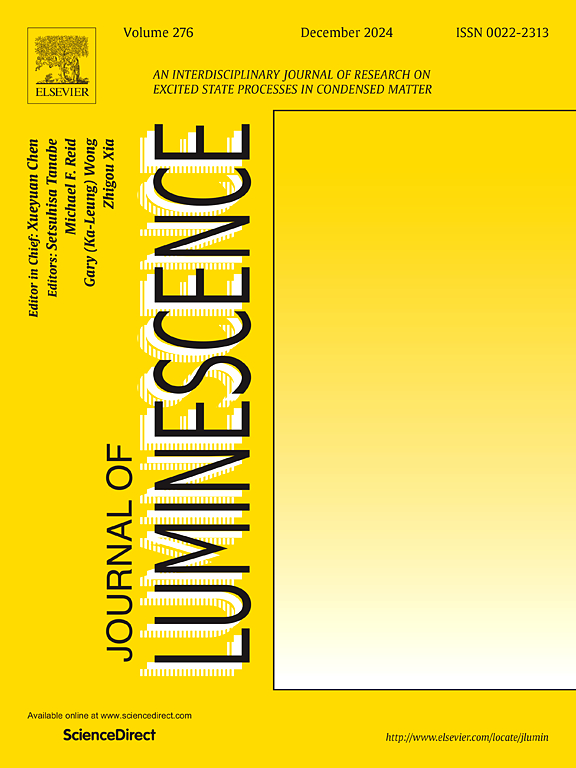Short-chain ligand synthesis of ytterbium-doped CsPbCl3 perovskite nanocrystals
IF 3.3
3区 物理与天体物理
Q2 OPTICS
引用次数: 0
Abstract
Synthesis of lanthanide-doped perovskite nanocrystals generally utilizes long-chain ligands like oleylamine and oleic acid at high temperatures up to 260 °C. To tackle this issue, we develop a strategy (temperatures down to 170 °C) to fabricate ytterbium (Yb3+)-doped CsPbCl3 perovskite nanocrystals using the octylamine ligand benefited from its low boiling point and short carbon chain. The as-prepared Yb3+-doped CsPbCl3 perovskite nanocrystals can yield both violet luminescence assigned to exciton recombination and near-infrared emission ascribed to Yb3+: 2F5/2 → 2F7/2. Structural and spectroscopic characterizations evidence that energy transfer from CsPbCl3 to Yb3+ and from defect states to Yb3+ are simultaneously responsible for the observed Yb3+ luminescence with quantum yield of 49.5 %. Femtosecond transient absorption spectra confirm that the transferring time scale is within 100 ps, which is much faster than the photoluminescent decay lifetimes of 3000 ps, enabling efficient CsPbCl3-to-Yb3+ energy transfer and thus Yb3+ luminescence.
掺镱CsPbCl3钙钛矿纳米晶体的短链配体合成
镧系掺杂钙钛矿纳米晶体的合成一般采用长链配体,如油胺和油酸,在高达260℃的高温下进行。为了解决这一问题,我们开发了一种策略(温度降至170°C),利用辛胺配体的低沸点和短碳链来制备掺镱CsPbCl3钙钛矿纳米晶体。制备的Yb3+掺杂CsPbCl3钙钛矿纳米晶体可以产生激子复合的紫色发光和Yb3+: 2F5/2→2F7/2的近红外发光。结构和光谱表征表明,从CsPbCl3到Yb3+和从缺陷态到Yb3+的能量转移同时导致了Yb3+的发光,量子产率为49.5%。飞秒瞬态吸收光谱证实转移时间尺度在100 ps以内,远快于光致发光衰减寿命3000 ps,实现了cspbcl3 -Yb3+的高效能量转移,从而实现了Yb3+的发光。
本文章由计算机程序翻译,如有差异,请以英文原文为准。
求助全文
约1分钟内获得全文
求助全文
来源期刊

Journal of Luminescence
物理-光学
CiteScore
6.70
自引率
13.90%
发文量
850
审稿时长
3.8 months
期刊介绍:
The purpose of the Journal of Luminescence is to provide a means of communication between scientists in different disciplines who share a common interest in the electronic excited states of molecular, ionic and covalent systems, whether crystalline, amorphous, or liquid.
We invite original papers and reviews on such subjects as: exciton and polariton dynamics, dynamics of localized excited states, energy and charge transport in ordered and disordered systems, radiative and non-radiative recombination, relaxation processes, vibronic interactions in electronic excited states, photochemistry in condensed systems, excited state resonance, double resonance, spin dynamics, selective excitation spectroscopy, hole burning, coherent processes in excited states, (e.g. coherent optical transients, photon echoes, transient gratings), multiphoton processes, optical bistability, photochromism, and new techniques for the study of excited states. This list is not intended to be exhaustive. Papers in the traditional areas of optical spectroscopy (absorption, MCD, luminescence, Raman scattering) are welcome. Papers on applications (phosphors, scintillators, electro- and cathodo-luminescence, radiography, bioimaging, solar energy, energy conversion, etc.) are also welcome if they present results of scientific, rather than only technological interest. However, papers containing purely theoretical results, not related to phenomena in the excited states, as well as papers using luminescence spectroscopy to perform routine analytical chemistry or biochemistry procedures, are outside the scope of the journal. Some exceptions will be possible at the discretion of the editors.
 求助内容:
求助内容: 应助结果提醒方式:
应助结果提醒方式:


